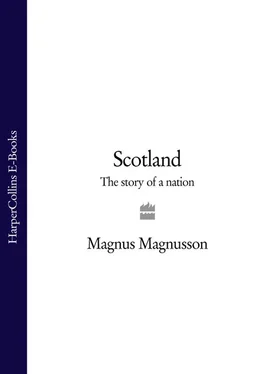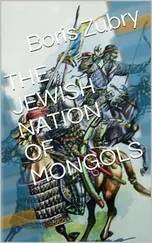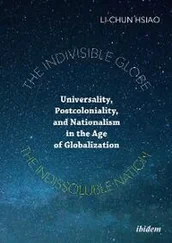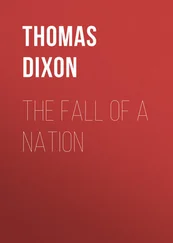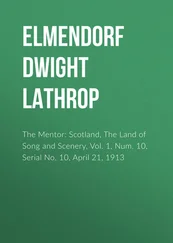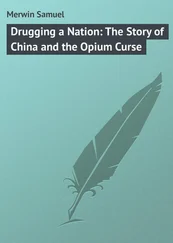1 ...8 9 10 12 13 14 ...20 The Aberlemno cross-slab seems to have been made early in the eighth century; it is tempting to interpret it as a memorial depiction of the Battle of Dunnichen itself. In the bottom right-hand corner an outsize Northumbrian (the size signifies a person of rank – perhaps Ecgfrith himself) lies dead on his side, his helmeted corpse now carrion for ravens. 1
The outcome of the battle was decisive, according to the Venerable Bede:
Henceforward the hopes and strength of the English realm began to waver and slip backwards ever lower. The Picts recovered their own lands which had been occupied by the English … Many of the English at this time were killed, enslaved or forced to flee from Pictish territory.
The battle marked the end of the Anglian/Northumbrian ascendancy in Scotland: from then on, the Northumbrians were never to be a power in the lands north of the Forth. Modern historians now claim that it was the Battle of Dunnichen which paved the way for northern Britain eventually to become the independent nation of Scotland and not just a northern extension of England. Some have even compared it to Bannockburn as ‘the most decisive battle in Scotland’s history’.
As for Bridei mac Bili, the conquering hero of Dunnichen, he died in 693 and was buried in the royal cemetery on Iona.
Half a century or more after the Battle of Dunnichen, it is said, there was another battle against the Northumbrians, of symbolic significance at least, which legend associates with the village of Athelstaneford, on the B1347 near Haddington, in East Lothian; this battle is traditionally believed to have provided Scotland with its patron saint, the apostle Andrew, and its banner, the saltire.
According to Walter Bower’s massive Scotichronicon , a Latin history of Scotland written in the 1440s, around 750 a Pictish warrior-king named Unust (729–61) was having the worst of a battle against the Northumbrians, when St Andrew appeared to him in a dream and promised him victory; this boost to Pictish morale apparently did the trick, assisted by another supernatural omen – a huge cloud-formation against the blue sky in the shape of a saltire (a diagonal cross, the crux decussata , on which Andrew was said to have been crucified at Patras in Achaia). Hence the adoption of St Andrew as Scotland’s patron saint, and the blue-and-white saltire banner as the symbol of Scotland’s nationhood.
The early Church in Scotland built up the cult of St Andrew by promoting the story that some of the saint’s relics had been brought to Scotland at the behest of an angel by St Rule (Regulus) in the fourth century; a shrine was built for the relics at Kilrymont, which later became the site of the great cathedral of St Andrews. Having Andrew as its patron saint was a great coup for Scotland: he had been the first of the apostles whom Jesus had called. St Andrews quickly became a renowned centre for evangelisation and pilgrimage.
The tourist trade today is as important to the Scottish economy as the pilgrim trade was then – and Athelstaneford, as ‘the birthplace of Scotland’s flag’, has seen no reason to miss out. In 1965 a commemorative cairn was erected in the graveyard of the parish church, incorporating a granite panel showing two armed hosts facing one another beneath the St Andrew’s Cross in the sky, and the inscription:
Tradition says that near this place in times remote Pictish and Scottish warriors about to defeat an army of Northumbrians, saw against a blue sky a great white cross like Saint Andrew’s, and in its image made a banner which became the flag of Scotland.
Beside the cairn the saltire flies permanently on a tall white flagpole. A Flag Heritage Centre was established there in 1996 in a converted sixteenth-century doocot (dovecote).
To the west of the Lowlands there was another realm – or rather, another shifting conglomeration of petty kingdoms and principalities – which took in a huge stretch of land from the Clyde down through today’s Dumfries and Galloway, over Hadrian’s Wall and across the Solway as far south as the present Lake District. This was the kingdom of the Britons – basically, Cumbria; but, as with Northumbria, we must not confuse its boundaries with those of today’s Cumbria. The original Cumbria was the Latinised ancient name for this territory of the Britons, derived from a variant of the same word as modern Welsh Cymry , the name of the peoples there. In the sixth century this Brittonic realm may well have been the home ground of Arthur (Arturus), a Romanised British war-leader who was promoted, in legend, into a great European champion of Christianity, the ‘once and future king’ of the Britons.
Within this British realm of Cumbria two separate kingdoms emerged north of Hadrian’s crumbling wall. One was Strathclyde, whose boundaries stretched as far south as Penrith. Its power-centre was at the basalt Rock of Clyde ( Altcluith , Dumbarton Rock), where Dumbarton Castle now stands. Its ‘spiritual’ centre seems to have been in the Govan area, somewhere near Govan Old Parish Church; this church now houses an impressive collection of thirty-one pieces of sculpted stonework dating from the ninth to the eleventh centuries, including a magnificently carved giant sarcophagus.
The British of Strathclyde reached the height of their power in the seventh century; Strathclyde survived as a client kingdom of Alba until the Battle of Carham in 1018 (see below), where the last native king of Strathclyde, Owain the Bald, was killed.
The other British kingdom was Rheged, based on Carlisle and covering Galloway in the extreme south-west of Scotland. Rheged is the most shadowy of all the kingdoms of the ‘Dark Ages’. One name stands out from ancient Welsh poetry: that of Urien, king of Rheged, whose exploits were hymned by the Welsh bard Taliesin. In 590 he took part in a siege of the Anglian stronghold on the island of Lindisfarne, off the north-east coast of England, but was assassinated by a rival British king who was jealous of his prowess.
The people the Romans called Scoti originally came from Ireland. The name was just a term of opprobrium applied by the Roman authors to describe raiders from Ireland, and probably meant, simply, ‘pirates’; it differentiated the Scoti from the Picti of mainland Scotland. The Scoti had raided in the Hebrides and the western mainland of Scotland, they had taken part in the ‘Barbarian Conspiracy’ which overran the Roman province of Britannia in 367 ( see Chapter 2), and they had probably been coming across the North Channel to settle in the west of Scotland for quite a long time. Around the year 500, however, tradition suggests that there was a positive ‘migration’ of the Scoti to Scotland: the seventh-century Irish Senchus fer nAlban (‘Tradition of the Men of Scotland’) records the story that the Scoti, under their king Fergus Mór mac Eirc, an enterprising hero in the legendary mould, moved in strength from Antrim in north-eastern Ireland across the North Channel to the rugged, mountainous, island-haunted terrain of Argyll in the west of Scotland. These people were known as the Dál Riata; they spoke Gaelic, and established a new kingdom in the territory of modern Argyll which came to be known as Dalriada. 1
The Gaelic-speaking Dál Riata in Argyll and the adjacent Inner Hebrides soon started to colonise farther afield. By the end of the sixth century they were hammering at the boundaries of neighbouring states, led by a series of aggressive warrior kings. One of those whose names are writ large in the Annal of Scotland was Áedán mac Gabhráin, overlord of Dalriada from 574 to 603, whose recorded exploits included large-scale raids by land and sea against the territories of the Picts, the Britons of Strathclyde and the Anglians of Northumbria. He was eventually defeated and killed by the Northumbrians in 603.
Читать дальше
